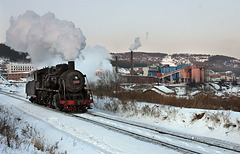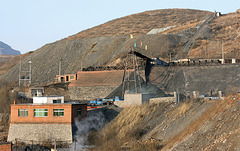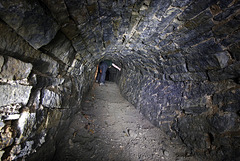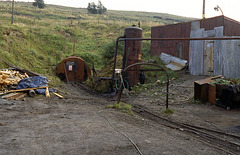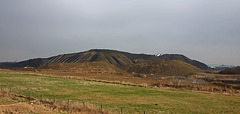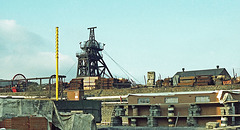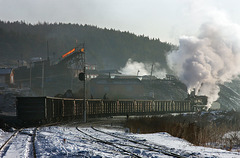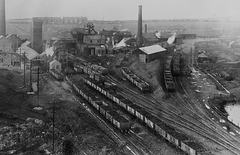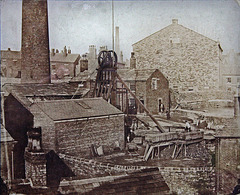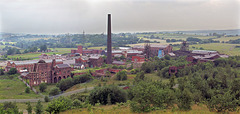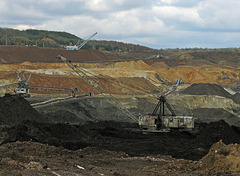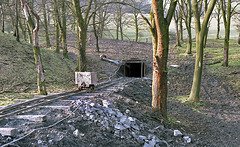
Coal Mining
Leaving Pingang Mine
| |
|
As the light fades on a winter afternoon, SY 1018 heads away from the Pingang Colliery on the Lishu system of the Jixi Coal Railway.
Mining Nanpiao style
| |
|
There are large numbers of small mines like this around Sanjiazi in the Nanpiao area. This drift is wound from an enginehouse off to the left of the frame whilst the dirt tip haulage is at the summit of the incline at top right.
Mr Clayton's flue
| |
|
The ventilation chimney on Kerridge Hill has a long flue running up the hillside at a shallow depth. This is very steep and has clearly never seen use as the stonework is very clean. A significant investment in the 1840s for absolutely no return.
Almost a Foxfield sunrise
Clarghyll
| |
|
Clarghyll Colliery in its later years when operation was intermittent at best. A view towards the drift with the very best in corrugated iron workshops to the right.
The red tip
| |
|
Red shale spoil tip from one of the Hogshaw collieries high up above Britannia. I assume that the red colouring is due tot he tip having been on fire at some time.
Disused adit
| |
|
On my wanderings around north-west England I sometimes happen upon interesting mining remains. This disused adit marks the entrance to upland coal workings in the thin seams of the lower coal measures. The area in front of the adit has been partly filled with rubble and silt and would once have been quite a bit lower. I suspect that there was once a structure over the entrance and that the little alcove on the left may have been for placing a lamp or candle.
Cutacre Tip, Little Hulton
| |
|
The Cutacre Tip at Little Hulton was the largest remaining colliery spoil tip in Lancashire. Mine waste was initially deposited around the early collieries at Wharton Hall but it was in the 20th century that the tip developed to its present size as valley of the Cutacre Brook, became the dumping ground for mine waste from the larger Brackley Colliery to the north and from Moseley Common Colliery to the south east. This continued until the last of these collieries closed in the 1960s.
Wholaw Nook Colliery
| |
|
Whilst on a walk with Clive Seal, the renowned expert on the local colieries, we visited the site of Wholaw Nook Pit just north of Clowbridge Reservoir. This was sunk in the mid-19th century with two shafts 30 yards deep to the Lower Mountain Mine which averaged 3ft 3 ins thickness. Worked by Messrs Brooks and Pickup the colliery was abandoned in 1887. The remains include the tops of the shafts and stone beds for the winding engine.
Kents Lane, Silverdale
| |
|
Silverdale Colliery was first sunk in the 1830s and went on to be the last deep mine operating in North Staffordshire when the final coal was worked here in December 1998. This is the No.17 shaft which was 1019 feet deep. There were four shafts numbered 14, 15 16 & 17 and four surface drifts in the 1980s.
Taiping Mine
| |
|
Another industrial line that has now seen the end of steam operations is the Lishu section of the Jixi Coal Railway. In happier times a train is seen being loaded at the Taiping Mine. It is standing on what was, until a couple of years earlier, the branch up to Sijing Cokeworks and Qikeng Colliery. The men standing in the wagons are levelling the load with shovels.
Talk o' th' Hill Colliery
| |
|
Another one from the tarchives.
The North Staffordshire Coal & Iron Company leased this colliery from Ralph Sneyd in the 1860s in conjunction with a short-lived ironworks (1862-73). Later run by the Talke o' th' Hill Colliery Company, in 1920 it was acquired by Deeside steelmakers John Summers & Sons Limited who also owned the Shelton Iron & Steel Co Ltd. Closure came in March 1928 with over 1000 people made unemployed.
The photograph was taken from on top of the bunkers associated with the battery of 70 Simon Carves bye-product coke ovens on the site. These replaced a several ranges of beehive coke ovens around 1900. There were two shafts here with the upcast (No.2) just out of view on the left. The downcast shaft (No.1) was 384 yards deep to the Bullhurst seam. The buildings in front of the chimney on the right were used to repair railway wagons and locomotives.
Holebottom Colliery
| |
|
|
Holebottom Colliery was situated on Moss Street (now named Fairbottom Street) in Oldham. In 1854 the colliery was operated by Lees, Jones and Co, and this continued until 1878
The photograph shows Fairbottom Street in the middle of the 19th century. The base of the colliery chimney stack was later covered up by the front stalls of the Kings Cinema, which was built in 1911. The pit shaft is also now under buildings. The large building in the background, is the back of the Theatre Royal on Horsedge Street. The Coliseum, which was built in 1887 would appear later on the extreme right of this view.
In 1856 the pit was part of a valuation of the assets of Lees, Jones and Company. the equipment was listed as:
One pair headstocks, pulleys, capstan and cages
One 24 horse, condensing engine with pumping gear complete
One 20 horse, H.P. winding engine, with winding gear complete
One hemp and one wire rope
Two boilers fitted up complete
One boiler house and chimney
One wire capstan rope
Smith shop and store rooms
1305 pairs of rails with iron sleepers
69 3-basket wagons
2 houses at Holebottom
In August 1876 the rotary beam engine at Holebottom was giving 17 strokes/minute and the pumps working 6 strokes/minute. The shaft was 177 yards deep to the Lower Bent seam, passing through five other seams on the way
Operation passed to Jones and Company in 1878 but legal disputes and geological problems led to closure around 1880.
Redacre Colliery
| |
|
Another of those interesting bumps in the ground that need to be researched and explained. This lies in a narrow isthmus of the Parish of Pott Shrigley which bumps up against the three adjacent parishes of Lyme Handley, Poynton and Adlington and makes for some interesting coal mining development on the different estates.
In the late 1840s the land here was in the ownership of the executors of the late William Turner, textile manufacturer from Blackburn who had purchased a lot of Pott Shrigley from the Downes family in the early nineteenth century and then moved into their ancestral home at Shrigley Hall. The 1848 tithe map shows a trackway from a wharf on the canal to the site of this pit and I suspect that coal was being trammed up to the boats at this time by the lessees Samuel Hunt & Co. By the early 1880s the pit was being operated by the Needham family who had originated in nearby Worth but had for many years operated collieries in Hurdsfield, Macclesfield. George Needham is listed as owner and manager in an 1884 list of collieries, but he had died in 1880 and I suspect that by then the colliery was being run by his son Joseph who was living with his family at Red Acre at the time of the 1881 census. He stated his occupation as Engine Man as he had been since the 1850s at Hurdsfield. By 1888 operations appear to have ceased and the tramway is noted as disused. Joseph went off to Chorlton to become a coal merchant.
The tramroad embankment is seen running in from the right side of the photograph and the spoil tip of the pit is left centre. The extract from the 1882 Ordnance Survey map has the tramroad alignment running up from the bottom and the position from which the photograph was taken marked with a red X. The shaft here was 255ft deep to the Arley seam which is locally known as the Redacre Mine and is about 2ft thick. It is a good quality coal and burned well when I tried the pieces collected from the spoil tip.
Hongshila colliery
| |
|
Two drifts, screens and an incline up onto the waste tips. A typical Chinese small coal mine at Hongshila in the Nanpiao District.
Chatterley Whitfield
| |
|
|
The sad remains of Chatterley Whitfield Colliery in North Staffordshire which closed in 1976 and was subsequently operated as a mining museum until that failed in 1993. There are four headgears surviving on this site. They are, seen are, from the left, Winstanley, Institute, Platt, and Hesketh shafts. I suspect that it will all fall down eventually as nothing useful seems to be being done to conserve the site. The local council has complete paranoia about health and safety, far beyond what is sensible in my opinion, and will not allow visitors on the rare open days to see anything much of interest. Meanwhile there is a Friends group for the site, but they have never yet answered any of my emails and do not seem interested in actually gaining support from anyone outside their own closed circle. All-in-all a sad state of affairs.
Vreoci dragline
| |
|
Bands of colour across the extensive brown coal workings of the Vreoci opencast mine in Serbia.
Tub on the line
| |
|
Track from the hauler leading into the adit at one of the many private coal mines in the Silverdale area of North Staffordshire.
Jump to top
RSS feed- Latest items - Subscribe to the latest items added to this album
- ipernity © 2007-2024
- Help & Contact
|
Club news
|
About ipernity
|
History |
ipernity Club & Prices |
Guide of good conduct
Donate | Group guidelines | Privacy policy | Terms of use | Statutes | In memoria -
Facebook
Twitter

